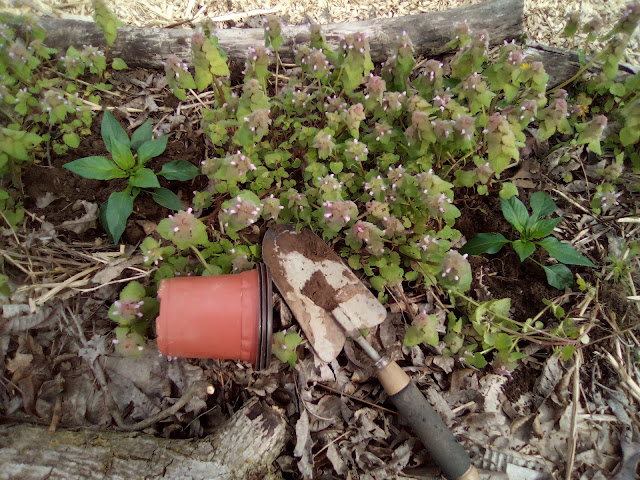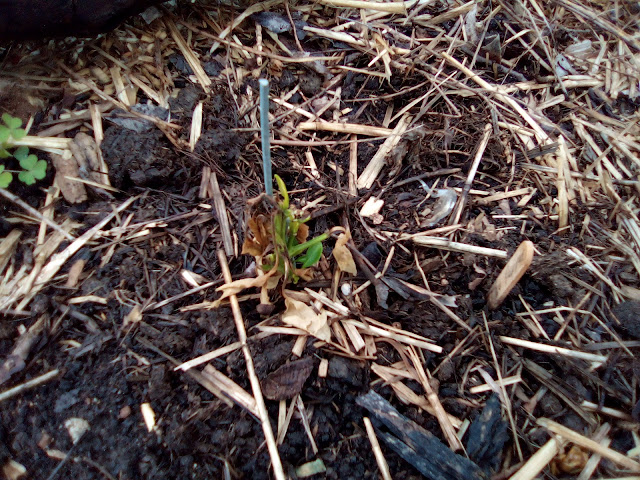When I set out my Jimmy Nardelo peppers on April 7th, the plants actually looked pretty good.
 |
| Jimmy Nardelo sweet peppers, transplanted into a row of red deadnettle (which will die back very soon). |
They didn't grow too much, I think because while we had a few days with temperatures near or just above 80° F, much of April has been cooler than normal. But they still looked healthy enough that I wasn't worried about them, and knew they'd take off growing once the weather warmed up.
On April 15, our temperature was around 83° F with a light breeze. But as strong cold front came barreling through, the temperatures started to drop and the winds started to pick up.
It was a sustained wind of more than 20 mph for most of the afternoon and evening, with frequent gusts approaching 40 mph. It was a very disagreeable afternoon to be outside and as I took Mo around the yard, the trees and other plants were being whipped around something fierce. I noticed lots of tender young tree leaves scattered around in the yard and garden....
The wind died down overnight, but picked back up by 9 am the next morning...not quite as strong, but still sustained winds of around 20 mph gusting to around 35 mph through the afternoon.
By the 17th, the wind had calmed back down a bit. There was still a good breeze but it wasn't what Winnie-the-Pooh would have called a "very blustery day."
But as I walked Mo around the yard that morning, I was horrified when I looked at my Jimmy Nardelo peppers...most of them looked practically dead!
As I made my way around the garden, I was even more horrified to discover that it wasn't just the Jimmy Nardelo peppers....
The pumpkins....
Almost every San Marzano tomato plant in the Hügelkulture bed....
Some of the yellow squash plants....
 |
You get the idea. Almost every "warm season" plant that I had set out in the garden had taken some damage. Many of them had been looking pretty good and now they looked brown and sick.
What had happened????!!!!
I actually asked RAF later that day, "Did we get a frost sometime in the last few days?" He kind of looked at me like I was maybe a little bit off my rocker and told me that it hadn't gotten cold enough for frost. I didn't think it had, but the plants sure looked bad.
I tried to remember...had I watered them and gotten water on the leaves while the sun was very bright, causing "sun scaled?" Yes, I had watered some of them, but not all of them.
Had I watered them with water that was contaminated with something? No, the water that I used was the same rain water from my barrels that I had been using.
Had I put compost around them and burned the roots? Yes, I had put compost around some of them, but not all of them, and some of the plants that I had added compost to looked just fine.
I finally came to the conclusion that my little plants were suffering from "leaf scorch" caused by the wind.
Over the next few days, I started to get a better idea of which plants might make it, and which ones wouldn't. The pumpkin had lost its big outer leaves, but the new leaves in the center were fine, and it didn't take long for it to green up again.
The San Marzano tomatoes are hit and miss. Some will not survive, but a few have greened back up and might be ok.
But alas...the Jimmy Nardelo peppers have probably taken a death blow. Out of the seven plants I originally set out, one was cut off by a cutworm, and five of the remaining six were hit hard by the wind.
It really seems miraculous to me looking at the row of peppers that even one plant survived. I wonder if it was saved by the henbit growing up around it. Did the henbit give it just enough protection to save it?
That seems to be the pattern across the entire garden. Anywhere a plant was somewhat sheltered or protected, the damage was little to none.
For example, the Rutgers tomatoes on the west end of the row were hit hard...the winds was out of the west/northwest and those plants didn't have any protection at all. But the plants that were on the south side of the trellis opposite the crimson clover cover crop didn't show any signs of damage at all.
The butternut and spaghetti squash plants were planted on the east slope of the Hügelkultre row, and they didn't suffer any damage either. The San Marzano tomatoes on the north end of the row were hit harder than those on the south end.
Apparently anything that even slightly blocked or disrupted that wind was enough to lessen the damage. I've learned something new.
So where to go from here? It's really too late to start new plants for summer, and really too early to start them for fall, but I did go ahead and plant about five more Jimmy Nardelo pepper seeds on April 19th - the first one was coming up today.
I'm starting over.
Update: After my little sister read this post, she messaged me and said she checked her calendar, and she had recorded a low of 32° F on April 17th, with a light frost. So this could very well have been frost damage. If that's the case, it totally caught me by surprise, and teaches me that I need to pay closer attention to the weather forecast!!!!






